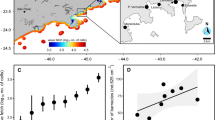Summary
Petraitis (1990) recently critized previous generalizations regarding the effects of predation in the New England rocky intertidal region (e.g., Menge 1976; Lubchenco and Menge 1978). Contrary to Lubchenco's and my conclusions, Petraitis concluded that (1) barnacles and not mussels are the favored prey of dogwhelks and (2) barnacles and not dogwhelks control mussel abundances in the mid and low rocky intertidal region. I provide evidence that these criticisms are unwarranted. First, Lubchenco and I never claimed that diet composition reflected prey preference. Moreover, predators can influence prey abundance without preferring the prey. Hence, claims regarding preferences have no bearing on our conclusions. Second, Petraitis' experiments do not invalidate Lubchenco's and my experimental results. Reanalyses of our experimental data support the earlier conclusion that at wave-sheltered sites, whelks reduce the abundance of mussels independently of barnacle abundances. Further, at all but one of Lubchenco's and my study sites, predator densities were higher than at Petraitis' site. Thus, the absence of a predator effect in Petraitis's study was most likely due to low predator density rather than a lack of generality of our earlier results. This reevaluation therefore suggests that within a broader conceptual framework, Petraitis' apparently divergent results are actually consistent with ours.
Similar content being viewed by others
References
Carpenter SC (1990) Large-scale perturbations: opportunities for innovation. Ecology 71:2038–2043
Caswell H (1978) Predator-mediated coexistence: a nonequilibrium model. Am Nat 112:127–154
Connell JH (1961) Effects of competition, predation by Thais lapillus, and other factors on natural populations of the barnacle Balanus balanoides. Ecol Monogr 31:61–104
Dayton PK (1971) Competition, disturbance, and community organization: the provision and subsequent utilization of space in a rocky intertidal community. Ecol Monogr 41:351–389
Diamond J (1986) Overview: laboratory experiments, field experiments, and natural experiments. In: Diamond J, Case TJ (eds) Community Ecology, Harper and Row, NY. pp 3–22
Edwards DC, Conover DO, Sutter III F (1982) Mobile predators and the structure of marine intertidal animals. Ecology 63:1175–1180
Fairweather PG, Underwood AJ (1983) The apparent diet of predators and biases due to different handling times of their prey. Oecologia 56:169–179
Hastings A (1980) Disturbance, coexistence, history, and competition for space. Theor Pop Biol 18:363–372
Landenberger DE (1968) Studies on selective feeding in the Pacific starfish Pisaster in Southern California. Ecology 49:1062–1075
Lubchenco J (1980) Algal zonation in the New England rocky intertidal community: an experimental analysis. Ecology 61:333–344
Lubchenco J (1983) Littorina and Fucus: effects of herbivores, substratum heterogeneity, and plant escapes during succession. Ecology 64:1116–1123
Lubchenco J (1986) Relative importance of competition and predation: early colonization by seaweeds in New England, In: Diamond J, Case TJ (eds) Community Ecology. Harper and Row, NY. pp 537–555
Lubchenco J, Menge BA (1978) Community development and persistence in a low rocky intertidal zone. Ecol Monogr 48:67–94
Louda SM (1982) Distribution ecology: variation in plant recruitment over a gradient in relation to insect seed predation. Ecol Monogr 52:25–41
Mauzey KP, Birkeland C, Dayton PK (1968) Feeding behaviro of asteroids and escape responses of their prey in the Puget Sound region. Ecology 49:603–619
Menge BA (1972) Foraging strategy of a starfish in relation to actual prey availability and environmental predictability. Ecol Monogr 42:25–50
Menge BA (1976) Organization of the New England rocky intertidal community: role of predation, competition and environmental heterogeneity. Ecol Monogr 46:355–393
Menge BA (1978a) Predation intensity in a rocky intertidal community. Relation between predator foraging activity and environmental harshness. Oecologia 34:1–16
Menge BA (1978b) Predation intensity in a rocky intertidal community. Effect of an algal canopy, wave action and desiccation on predator feeding rates. Oecologia 34:17–35
Menge BA (1982) Reply to a comment by Edwards, Conover, and Sutter. Ecology 63:1180–1184
Menge BA (1983) Components of predation intensity in the low zone of the New England rocky intertidal region. Oecologia 58:141–155
Menge BA (1991) Relative importance of recruitment and other causes of variation in rocky intertidal community structure. J Exp Mar Biol Ecol 146:69–100
Menge BA, Lubchenco J (1981) Community organization in temperate and tropical rocky intertidal habitats: prey refuges in relation to consumer pressure gradients. Ecol Monogr 51:429–450
Menge BA, Sutherland JP (1976) Species diversity gradients: synthesis of the roles of predation, competition, and temporal heterogeneity. Am Nat 110:351–369
Menge BA, Sutherland P (1987) Community regulation: variation in disturbance, competition, and predation in relation to environmental stress and recruitment. Am Nat 130:730–757
Menge BA, Farrell TM (1989) Community structure and interaction webs in shallow marine hard-bottom communities: tests of an environmental stress model. Adv Ecol Res 19:189–262
Menge BA, Olson AM (1990) Role of scale and environmental factors in regulation of community structure. Trends Ecol Evol 5:52–57
Morrison DF (1976) Multivariate statistical methods, 2nd edition. McGraw-Hill, NY
Paine RT (1969) The Pisaster-Tegula interaction: prey patches, predator food preference, and intertidal community structure. Ecology 50:950–961
Paine RT (1980) Food webs: linkage, interaction strength and community infrastructure. J Anim Ecol 49:667–685
Peterson CH, Bradley BP (1978) Estimating the diet of a sluggish predator from field observations. J Fish Res Board Can 35:136–141
Petraitis PS (1987) Factors organizing rocky intertidal communities of New England: herbivory and predation in sheltered bays. J Exp Mar Biol Ecol 109:117–136
Petraitis PS (1990) Direct and indirect effects of predation, herbivory and surface rugosity on mussel recruitment. Oecologia 83:405–413
Schoener TW (1989) Food webs from the small to the large. Ecology 70:1559–1589
Seed R (1976) Ecology In: Bayne BL (ed) Marine Mussels: Their Ecology and Physiology. Cambridge Univ Press, Cambridge. pp 13–65
Sih A, Crowley P, McPeek M, Petranka J, Strohmeier K (1985) Predation, competition, and prey communities: a review of field experiments. Ann Rev Ecol Syst 16:269–311
Sokal RR, Rohlf FJ (1981) Biometry, second edition. WH Freeman, San Francisco
Author information
Authors and Affiliations
Rights and permissions
About this article
Cite this article
Menge, B.A. Generalizing from experiments: is predation strong or weak in the New England rocky intertidal?. Oecologia 88, 1–8 (1991). https://doi.org/10.1007/BF00328396
Received:
Accepted:
Issue Date:
DOI: https://doi.org/10.1007/BF00328396




